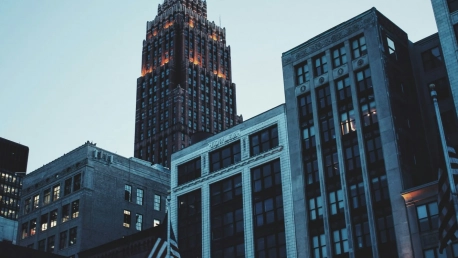The Detroit retail market is in the throes of a dramatic transformation characterized by the adaptive reuse of vacant properties and a renewed surge of interest from tenants and investors. This trend is breathing new life into Detroit’s retail landscape and revitalizing community and cultural hubs throughout the city. Faced with various economic pressures, increasing demand, and urban regeneration efforts, Detroit is poised to make what was old new again, showcasing a robust retail renaissance that speaks to the resilience and ingenuity of its stakeholders.
Adaptive Reuse and Urban Revitalization
Detroit’s urban revitalization is principally driven by the adaptive reuse of old and abandoned structures, rejuvenating what were once eyesores into vibrant community landmarks. A prominent example of this trend is the reopening of Michigan Central Station by Ford Motor Co., turning a decaying relic into a bustling center of technology and innovation. This transformation is not an isolated case; it’s part of a larger movement to blend Detroit’s rich history with modern needs. Other significant projects include the redevelopment of the erstwhile J.L. Hudson’s department store site and the transformation of the previously abandoned Southwest Detroit Hospital. These redevelopment efforts foster a unique blend of technology, culture, and community engagement, encapsulating the spirit of urban regeneration.The drive for revitalization extends beyond these iconic buildings, touching smaller vacant properties throughout Detroit. These projects range from mixed-use developments to specialized retail spaces, meeting contemporary needs while preserving the city’s unique architectural heritage. Many investors and developers now see value in properties that were once deemed too costly to refurbish, betting on their potential for long-term gains. This trend of adaptive reuse is not only born out of economic necessity but also fueled by a broader commitment to maintaining Detroit’s historical and cultural fabric.
Population Growth and Affordable Housing Initiatives
Detroit’s population growth for the first time since 1957, measured between July 2022 and July 2023, marks a monumental shift, fueled by significant investments in affordable housing. The city has channeled over $1 billion into programs aimed at preserving or developing more than 4,600 affordable housing units. These efforts have enhanced neighborhood stability and attracted new residents, serving as a cornerstone of Detroit’s broader revitalization strategy. The influx of affordable housing contributes significantly to Detroit’s retail resurgence by driving demand for services and fostering a more engaged and stable community.Affordable housing initiatives are crucial for sustaining Detroit’s retail renaissance. As neighborhoods stabilize and grow, the need for retail services increases, prompting more retailers to seek spaces in the city. Improved housing affordability also addresses long-standing economic challenges, enhancing the overall quality of life for Detroit residents. This dynamic not only benefits local businesses by expanding their customer base but also enriches the community, making it more vibrant and attractive for future investments. The correlation between affordable housing efforts and the burgeoning retail sector underscores the holistic approach Detroit is taking to rejuvenate its urban environment.
High Demand and Limited Supply in Retail Space
The Detroit retail market is currently characterized by vigorous tenant demand, juxtaposed with a limited supply of high-quality retail spaces. Increased borrowing and construction costs have slowed new developments, leading to a mismatch where demand often exceeds supply. This imbalance forces retailers to consent to higher rents, intensifying the competitive nature of the market. Despite these challenges, Detroit has witnessed robust retail absorption, with a variety of businesses eager to establish their presence. From fast-casual restaurant chains to automotive service providers, a diverse mix of retailers is vying for space, reflecting the region’s untapped potential.Prominent brands such as Shake Shack, Cava, and Chick-fil-A are expanding their footprints, signaling strong confidence in Detroit’s retail prospects. Similarly, automotive service providers like Tommy’s Express Car Wash and Sheetz add to the vibrant tenant mix, highlighting the dynamic and multifaceted nature of the market. This influx of tenants is indicative of Detroit’s broader urban revival, as businesses recognize the potential for growth and opportunity in the city. The competitive scramble for retail spaces underscores the need for new developments, even as high costs pose significant challenges.
Investment Trends and Repurposing Vacant Properties
High construction costs have naturally steered investors towards the repurposing of vacant buildings, fostering a trend of adaptive reuse. Investor interest is particularly strong in multi-tenant properties, which offer economic resilience due to their diversified tenant base. Transactions are increasingly favoring these economically robust centers over single-tenant net-lease assets. This shift is driving a wave of adaptive reuse and redevelopment, as investors see the long-term potential in refashioning existing structures.One illustrative example of this trend is the repurposing of vacant Rite Aid properties. The bankruptcy restructuring of Rite Aid resulted in the closure of over 300 stores nationwide, freeing up numerous properties for redevelopment. These buildings are now being backfilled by a variety of alternative uses, from medical offices to hardware stores, providing valuable community services while fueling the retail market’s revival. This adaptability and willingness to reimagine vacant spaces are key factors contributing to Detroit’s ongoing revitalization. Investors are seizing these opportunities to reshape the retail landscape while generating returns, illustrating the symbiotic relationship between economic necessity and urban regeneration.
Lease and Sales Market Dynamics
The first quarter of 2024 reflected strong leasing activity in Detroit, demonstrating the city’s growing appeal to businesses. During this period, there were 292 leases signed totaling 923,124 square feet, leading to net absorption of 597,560 square feet—significantly higher than preceding quarters. Additionally, vacancy rates slightly decreased to 5.1 percent, underscoring the robust demand for retail space. Despite high borrowing costs, retail investment sales remained buoyant, reaching $70 million in the first quarter. This continued investment activity points to ongoing market momentum and investor confidence in Detroit’s retail sector.Retailers’ willingness to accept higher rents is paving the way for new construction opportunities. As retail spaces become more scarce, higher rental benchmarks justify the costs for landlords to pursue new development projects. This evolving dynamic suggests the potential for a new wave of construction if high rental rates persist. The willingness of retailers to bear elevated rents reflects strong belief in Detroit’s market potential and underlines the importance of continued investment in new developments. Overall, the lease and sales market dynamics paint a picture of a resilient and rebounding retail sector, poised for future growth.
Economic Pressures and Consumer Behavior
Retailers in Detroit are adapting to persistent economic pressures, including inflationary trends that impact both consumer spending and business operations. Rising costs influence tenant willingness to pay higher rents and the contributions landlords must make for tenant improvements. Despite these challenges, value-driven retail categories are expanding steadily, meeting consumer demands for affordable products. Stores like T.J. Maxx, HomeGoods, and Burlington exemplify this trend, responding to economic uncertainties with cost-effective options that resonate with budget-conscious shoppers.Economic pressures also shape consumer behavior, amplifying the demand for value-oriented retailers. This shift benefits both tenants and landlords, as customers seek more affordable choices amid ongoing economic challenges. The resilience of value-driven stores underscores their importance in Detroit’s retail landscape, providing necessary balance and stability. By addressing the diverse needs of consumers, these retailers help solidify Detroit’s position as a dynamic and adaptable retail market. This adaptation to economic conditions highlights the flexibility and responsiveness of the retail sector, ensuring its continued relevance and vitality in a changing economic environment.
Constraints in Investment Sales
The Detroit retail market is undergoing a significant transformation marked by the reclamation and adaptive reuse of vacant properties, igniting a renewed spark of interest from both tenants and investors. This movement is revitalizing Detroit’s retail environment and breathing new vitality into its community and cultural hubs. Economic pressures, coupled with increasing demand and focused urban regeneration efforts, have set the stage for Detroit to redefine itself by making the old new once again.The enthusiasm for adaptive reuse projects is evident in the way old buildings are being reimagined into vibrant retail spaces, supporting small businesses and fostering a sense of community. Investors are also taking note, seeing potential in Detroit’s upswing, thus pouring capital into redevelopment initiatives.As the city embraces this wave of change, local stakeholders—ranging from developers to shop owners and residents—are showcasing a level of resilience and creativity that underpins this retail renaissance. With an evolving market landscape, Detroit is not just rebuilding but reimagining its future, celebrating its history while paving the way for innovative growth. Solutions driven by this urban renewal are turning what were once symbols of decline into thriving economic and cultural landmarks. This ongoing retail revival speaks volumes about Detroit’s tenacity and its forward-thinking spirit.









